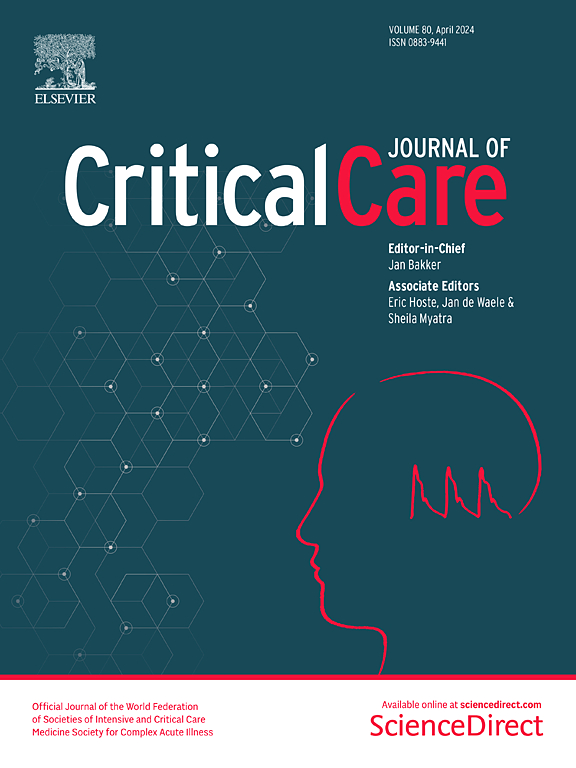通过潮气量挑战测试前负荷反应能力,以光电血流灌注指数进行评估
IF 8.8
1区 医学
Q1 CRITICAL CARE MEDICINE
引用次数: 0
摘要
为了检测潮气量(Vt)为 6 毫升/千克预测体重(PBW)的通气患者的前负荷反应性,Vt 挑战包括将 Vt 从 6 毫升/千克预测体重(PBW)增加到 8 毫升/千克,并测量脉压变化(PPV)的增加。不过,这需要动脉导管。灌注指数(PI)反映了光敏血压信号的振幅,可以反映每搏量,其呼吸变化(脉搏变异指数,PVI)可以估计 PPV。我们评估了 Vt 挑战诱导的 PI 或 PVI 变化是否与 PPV 变化一样可靠,可用于检测前负荷反应性,前负荷反应性的定义是 PLR 诱导的心脏指数(CI)增加≥ 10%。在 Vt = 6 mL/kg PBW 通气且无自主呼吸的重症患者中,在 Vt 挑战和 PLR 测试期间记录了血流动力学(PICCO2 系统)和光敏血流图(Masimo-SET 技术,传感器置于手指或前额)数据。在 63 名经过筛选的患者中,21 人(33%)因 PI 信号不稳定和/或心房颤动而被排除,42 人被纳入。在 16 名前负荷反应者进行 Vt 挑战期间,CI 下降了 4.8 ± 2.8%(百分比变化),PPV 上升了 4.4 ± 1.9%(绝对变化),PIfinger 下降了 14.5 ± 10.7%(百分比变化),PVIfinger 上升了 1.9 ± 2.6%(绝对变化),PIforehead 下降了 18.7 ± 10.9(百分比变化),PVIforehead 上升了 1.0 ± 2.5(绝对变化)。所有这些变化均大于前负荷无反应者。检测前负荷反应性的 ROC 曲线下面积(AUROC)为:Vt-挑战诱导的 CI 变化(百分比变化)为 0.97 ± 0.02,Vt-挑战诱导的 PPV 变化(绝对变化)为 0.95 ± 0.04,Vt-挑战诱导的 CI 变化(百分比变化)为 0.97 ± 0.02,Vt-挑战诱导的 PPV 变化(绝对变化)为 0.95 ± 0.04,Vt-挑战诱导的 CI 变化(百分比变化)为 0.98 ± 0.02。98 ± 0.02,Vt-挑战诱导的 PIforehead 变化(百分比变化)为 0.85 ± 0.05,Vt-挑战诱导的 PIfinger 变化(百分比变化)为 0.85 ± 0.05(与 PIforehead 相比,p = 0.04)。Vt 挑战诱导的 PVIforehead 和 PVIfinger 变化的 AUROC 明显大于 0.50,但小于 Vt 挑战诱导的 PPV 变化的 AUROC。在无自主呼吸和/或心房颤动的机械通气患者中,Vt-挑战期间检测到的 PI 变化能可靠地检测出前负荷反应性。在前额测量 PI 比在指尖测量 PI 更可靠。Vt 挑战期间 PVI 的变化也能检测前负荷反应性,但准确性较低。本文章由计算机程序翻译,如有差异,请以英文原文为准。
Testing preload responsiveness by the tidal volume challenge assessed by the photoplethysmographic perfusion index
To detect preload responsiveness in patients ventilated with a tidal volume (Vt) at 6 mL/kg of predicted body weight (PBW), the Vt-challenge consists in increasing Vt from 6 to 8 mL/kg PBW and measuring the increase in pulse pressure variation (PPV). However, this requires an arterial catheter. The perfusion index (PI), which reflects the amplitude of the photoplethysmographic signal, may reflect stroke volume and its respiratory variation (pleth variability index, PVI) may estimate PPV. We assessed whether Vt-challenge-induced changes in PI or PVI could be as reliable as changes in PPV for detecting preload responsiveness defined by a PLR-induced increase in cardiac index (CI) ≥ 10%. In critically ill patients ventilated with Vt = 6 mL/kg PBW and no spontaneous breathing, haemodynamic (PICCO2 system) and photoplethysmographic (Masimo-SET technique, sensor placed on the finger or the forehead) data were recorded during a Vt-challenge and a PLR test. Among 63 screened patients, 21 (33%) were excluded because of an unstable PI signal and/or atrial fibrillation and 42 were included. During the Vt-challenge in the 16 preload responders, CI decreased by 4.8 ± 2.8% (percent change), PPV increased by 4.4 ± 1.9% (absolute change), PIfinger decreased by 14.5 ± 10.7% (percent change), PVIfinger increased by 1.9 ± 2.6% (absolute change), PIforehead decreased by 18.7 ± 10.9 (percent change) and PVIforehead increased by 1.0 ± 2.5 (absolute change). All these changes were larger than in preload non-responders. The area under the ROC curve (AUROC) for detecting preload responsiveness was 0.97 ± 0.02 for the Vt-challenge-induced changes in CI (percent change), 0.95 ± 0.04 for the Vt-challenge-induced changes in PPV (absolute change), 0.98 ± 0.02 for Vt-challenge-induced changes in PIforehead (percent change) and 0.85 ± 0.05 for Vt-challenge-induced changes in PIfinger (percent change) (p = 0.04 vs. PIforehead). The AUROC for the Vt-challenge-induced changes in PVIforehead and PVIfinger was significantly larger than 0.50, but smaller than the AUROC for the Vt-challenge-induced changes in PPV. In patients under mechanical ventilation with no spontaneous breathing and/or atrial fibrillation, changes in PI detected during Vt-challenge reliably detected preload responsiveness. The reliability was better when PI was measured on the forehead than on the fingertip. Changes in PVI during the Vt-challenge also detected preload responsiveness, but with lower accuracy.
求助全文
通过发布文献求助,成功后即可免费获取论文全文。
去求助
来源期刊

Critical Care
医学-危重病医学
CiteScore
20.60
自引率
3.30%
发文量
348
审稿时长
1.5 months
期刊介绍:
Critical Care is an esteemed international medical journal that undergoes a rigorous peer-review process to maintain its high quality standards. Its primary objective is to enhance the healthcare services offered to critically ill patients. To achieve this, the journal focuses on gathering, exchanging, disseminating, and endorsing evidence-based information that is highly relevant to intensivists. By doing so, Critical Care seeks to provide a thorough and inclusive examination of the intensive care field.
 求助内容:
求助内容: 应助结果提醒方式:
应助结果提醒方式:


